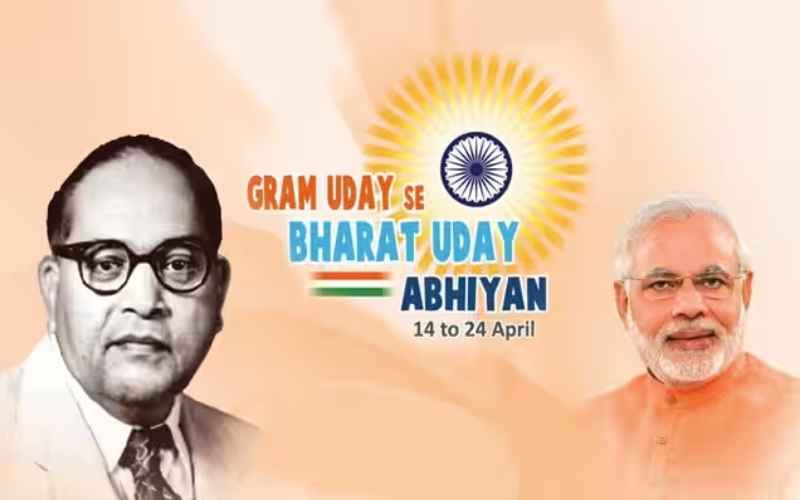India, a land of diverse cultures and vibrant traditions, has always found its roots in its villages. The essence of “Gramoday Se Bharat Uday” (From the Rise of Villages to the Rise of India) is deeply embedded in the belief that the true progress of India can only be achieved through the upliftment of its rural areas. This initiative aims to bridge the urban-rural divide, ensuring holistic development and a prosperous future for every citizen. Let’s delve into the facets of this transformative journey.

Vision and Objectives of “Gramoday Se Bharat Uday”
1. Empowering Rural Economy:
- Objective: Enhance agricultural productivity and support local industries to boost income-generating opportunities in rural areas.
- Approach:
- Implement modern farming techniques to increase yields.
- Provide better access to markets to ensure fair pricing for agricultural produce.
- Promote and support local industries and crafts to create diverse income sources.
2. Infrastructure Development:
- Objective: Develop world-class infrastructure to improve the quality of life and attract investments in rural areas.
- Approach:
- Construct and maintain better roads to improve connectivity.
- Ensure reliable electricity supply to power homes and businesses.
- Provide clean and safe water to all households.
- Enhance digital connectivity to bridge the digital divide and facilitate access to information and services.
3. Education and Skill Development:
- Objective: Equip rural youth with quality education and skills to compete in the global job market.
- Approach:
- Establish modern educational institutions with up-to-date curricula.
- Set up vocational training centers to provide job-specific skills.
- Promote digital literacy to enable access to online resources and opportunities.
4. Healthcare Accessibility:
- Objective: Make quality healthcare accessible to every rural household.
- Approach:
- Build well-equipped healthcare centers in rural areas.
- Implement telemedicine facilities to provide remote consultations and treatments.
- Deploy mobile health units to reach the most remote and underserved areas.
5. Social and Economic Equality:
- Objective: Ensure balanced development by promoting social and economic equality.
- Approach:
- Empower women and marginalized communities through targeted programs and initiatives.
- Guarantee access to basic amenities such as healthcare, education, and clean water for all citizens.
- Create opportunities for all to participate in and benefit from economic growth.
Summary
The vision of “Gramoday Se Bharat Uday” is to create a prosperous and self-reliant rural India by focusing on five key areas: empowering the rural economy, developing infrastructure, enhancing education and skill development, ensuring healthcare accessibility, and promoting social and economic equality. By addressing these critical areas, the initiative aims to transform rural communities, improve quality of life, and drive sustainable development across the nation.
Key Initiatives and Programs
1. Digital India for Rural Development:
- Objective: Bridge the digital divide and make government services more accessible and transparent.
- Initiatives:
- High-Speed Internet: Expand broadband connectivity to rural areas to facilitate digital inclusion.
- Common Service Centers (CSCs): Establish CSCs to provide various digital services, including government services, to rural populations.
- E-Governance: Implement e-governance solutions to streamline and make public services more efficient and transparent.
2. Swachh Bharat Abhiyan (Clean India Mission):
- Objective: Improve sanitation and hygiene to ensure a healthier environment in rural areas.
- Initiatives:
- Toilet Construction: Build and maintain toilets to eliminate open defecation.
- Waste Management: Promote waste segregation, recycling, and proper waste disposal practices.
- Awareness Campaigns: Conduct awareness programs to educate rural communities about the importance of cleanliness and hygiene.
3. Pradhan Mantri Gram Sadak Yojana (PMGSY):
- Objective: Enhance road connectivity to facilitate economic development in rural areas.
- Initiatives:
- All-Weather Roads: Construct and maintain durable roads to connect rural habitations.
- Access to Markets: Improve transportation links to facilitate easier access to markets for agricultural produce and other goods.
- Improved Access: Ensure better connectivity to education and healthcare facilities.
4. Deen Dayal Upadhyaya Grameen Kaushalya Yojana (DDU-GKY):
- Objective: Provide skill training and placement support to rural youth for sustainable livelihoods.
- Initiatives:
- Skill Training Centers: Set up centers to offer vocational and technical training tailored to market needs.
- Placement Support: Provide assistance in job placement and career guidance to trainees.
- Entrepreneurship Development: Encourage and support rural youth in starting their own enterprises.
5. Pradhan Mantri Awas Yojana (PMAY):
- Objective: Ensure safe and dignified living conditions by providing affordable housing to rural families.
- Initiatives:
- Pucca Houses: Construct durable houses with essential amenities for rural families.
- Basic Amenities: Ensure houses are equipped with basic facilities such as electricity, water, and sanitation.
- Subsidy and Financial Support: Provide financial assistance and subsidies to eligible families for house construction.
Summary
The key initiatives and programs under “Gramoday Se Bharat Uday” aim to transform rural India by focusing on critical areas such as digital connectivity, sanitation, infrastructure, skill development, and housing. These initiatives are designed to create a more inclusive and prosperous rural economy, ensuring that the benefits of development reach every corner of the country. By addressing these fundamental needs, the programs collectively work towards a vision of a stronger, healthier, and more self-reliant rural India.
Success Stories
1. Transforming Agriculture in Maharashtra:
- Background: Maharashtra’s drought-prone regions have historically faced severe agricultural challenges, leading to poor productivity and high migration rates.
- Initiatives Implemented:
- Watershed Management: Techniques to conserve and manage water resources, including rainwater harvesting and the construction of check dams, have been implemented.
- Drip Irrigation: Adoption of drip irrigation systems to ensure efficient water usage and improve crop yields.
- Farmer Education Programs: Training and support for farmers on modern agricultural practices, crop diversification, and sustainable farming methods.
- Impact:
- Increased Agricultural Productivity: Enhanced water availability and efficient irrigation methods have led to higher crop yields.
- Better Livelihoods: Improved agricultural output has increased farmers’ incomes, reducing the need for migration to urban areas.
- Sustainable Farming: Farmers are now better equipped to manage resources sustainably, ensuring long-term agricultural viability.
2. Digital Villages in Andhra Pradesh:
- Background: Many villages in Andhra Pradesh lacked basic digital infrastructure, limiting access to education, healthcare, and economic opportunities.
- Initiatives Implemented:
- High-Speed Internet: Provision of broadband connectivity to rural areas.
- E-Governance Services: Implementation of digital platforms for accessing government services, reducing bureaucratic hurdles and enhancing transparency.
- Digital Literacy Programs: Training programs to improve digital skills among villagers, enabling them to utilize digital tools and resources.
- Impact:
- Educational Opportunities: Access to online educational resources and e-learning platforms has improved the quality of education in rural areas.
- Healthcare Access: Telemedicine services and online health consultations have made healthcare more accessible to villagers.
- Entrepreneurship: Digital connectivity has opened up new business opportunities, with many villagers starting online ventures and benefiting from e-commerce.
3. Women Empowerment in Rajasthan:
- Background: Women in rural Rajasthan faced significant barriers to financial independence and social equality.
- Initiatives Implemented:
- Self-Help Groups (SHGs): Formation of SHGs to provide women with access to microfinance and collective bargaining power.
- Skill Training: Training programs to equip women with skills in areas such as handicrafts, tailoring, and small-scale entrepreneurship.
- Market Access: Assistance in accessing markets to sell their products, ensuring fair prices and wider reach.
- Impact:
- Financial Independence: Women in SHGs have gained access to microloans, enabling them to start and expand their businesses.
- Economic Contribution: SHGs have become significant contributors to the local economy, driving growth and development.
- Social Equality: Empowered women are now playing a more active role in their communities, challenging traditional gender roles and promoting social equality.
Summary
These success stories highlight the transformative impact of targeted initiatives in rural India. From enhancing agricultural productivity in Maharashtra to creating digital villages in Andhra Pradesh and empowering women in Rajasthan, these programs demonstrate the potential for sustainable development and social change. By addressing specific challenges and leveraging local strengths, “Gramoday Se Bharat Uday” is driving significant improvements in the quality of life and economic opportunities for rural communities.
Conclusion
“Gramoday Se Bharat Uday” is not just a slogan but a comprehensive vision aimed at transforming rural India. By focusing on economic empowerment, infrastructure development, education, healthcare, and social equality, this initiative strives to create a self-reliant and prosperous rural India. The success of this vision lies in the collective efforts of the government, private sector, and the rural community itself, working together to ensure that the rise of villages leads to the rise of the entire nation.
Join the Movement
The journey of “Gramoday Se Bharat Uday” requires the participation and support of every citizen. Whether through volunteering, spreading awareness, or contributing to rural development projects, each one of us can play a part in building a brighter and more inclusive future for India. Together, let’s ensure that the rise of our villages truly leads to the rise of our nation.
Sources:
- Government of India Official Websites
- Rural Development Reports
- Success Stories from Various States
Top 20 FAQs with Answers
1. What is the primary goal of “Gramoday Se Bharat Uday”?
- The primary goal is to promote comprehensive rural development by enhancing agricultural productivity, infrastructure, education, healthcare, and social equality to ensure sustainable growth and improved quality of life in rural areas.
2. How does “Gramoday Se Bharat Uday” aim to empower the rural economy?
- By promoting modern farming techniques, supporting local industries, providing fair pricing, and improving access to markets, the initiative aims to boost income-generating opportunities and economic growth in rural areas.
3. What infrastructure developments are included in the initiative?
- The initiative includes developing better roads, reliable electricity, clean water supply, and robust digital connectivity to improve living standards and attract investments in rural areas.
4. How does the initiative plan to enhance education and skill development?
- By setting up modern educational institutions, vocational training centers, and promoting digital literacy to equip rural youth with the skills needed to compete in the global job market.
5. What measures are being taken to improve healthcare accessibility in rural areas?
- The initiative focuses on establishing well-equipped healthcare centers, telemedicine facilities, and mobile health units to ensure quality healthcare reaches every rural household.
6. How does the initiative promote social and economic equality?
- By empowering women and marginalized communities, ensuring access to basic amenities, and providing equal opportunities for all citizens to participate in and benefit from economic growth.
7. What is the impact of the Digital India for Rural Development initiative?
- It bridges the digital divide by providing high-speed internet, setting up Common Service Centers (CSCs), and promoting e-governance, thereby making government services more accessible and transparent.
8. What are the key components of the Swachh Bharat Abhiyan in rural areas?
- Building toilets, promoting waste management, and creating awareness about cleanliness to ensure a healthier environment.
9. How does the Pradhan Mantri Gram Sadak Yojana (PMGSY) benefit rural areas?
- By constructing all-weather roads to connect rural habitations, facilitating easier access to markets, education, and healthcare facilities, thus boosting economic development.
10. What is the objective of the Deen Dayal Upadhyaya Grameen Kaushalya Yojana (DDU-GKY)?
- To provide skill training and placement support to rural youth, enabling them to secure sustainable livelihoods and contribute to the country’s economic growth.
11. How does the Pradhan Mantri Awas Yojana (PMAY) improve living conditions in rural areas?
- By providing pucca houses with basic amenities to all rural families, ensuring safe and dignified living conditions.
12. What is the role of self-help groups (SHGs) in women empowerment in rural areas?
- SHGs provide microfinance, skill training, and market access to women, promoting financial independence and social equality.
13. How has digital connectivity transformed villages in Andhra Pradesh?
- High-speed internet and digital literacy programs have opened up new avenues for education, healthcare, and entrepreneurship, transforming villages into digital hubs.
14. What success has been seen in agriculture in Maharashtra due to the initiative?
- Initiatives like watershed management, drip irrigation, and farmer education programs have significantly improved agricultural productivity, leading to better livelihoods and reduced migration to urban areas.
15. How does “Gramoday Se Bharat Uday” ensure sustainable farming practices?
- By educating farmers on modern agricultural techniques, crop diversification, and resource management to ensure long-term agricultural viability.
16. What is the impact of telemedicine facilities in rural healthcare?
- Telemedicine facilities have made healthcare more accessible, allowing remote consultations and treatments, thus improving health outcomes in rural areas.
17. How does the initiative address the needs of marginalized communities?
- By ensuring that these communities have access to basic amenities, education, healthcare, and economic opportunities, promoting social and economic equality.
18. What are the benefits of better road connectivity under PMGSY?
- Improved road connectivity facilitates easier access to markets, education, healthcare, and other essential services, enhancing the overall quality of life in rural areas.
19. How do vocational training centers help rural youth?
- Vocational training centers provide job-specific skills and career guidance, helping rural youth secure sustainable livelihoods and reducing unemployment.
20. What measures are taken to promote waste management in rural areas?
- The initiative promotes waste segregation, recycling, and proper disposal practices through awareness campaigns and infrastructure development for effective waste management.













